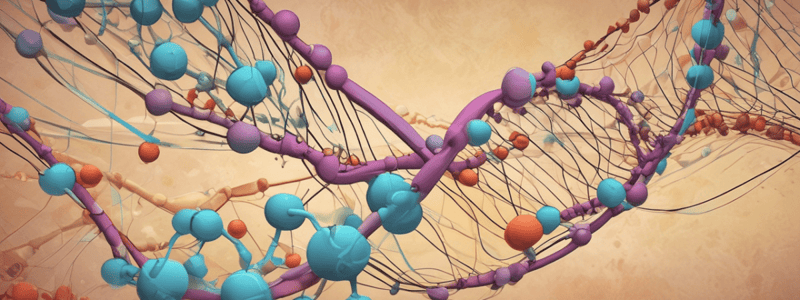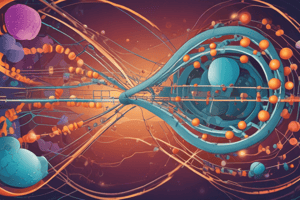Podcast
Questions and Answers
What is the primary reason for the high conservation of aminoacyl-tRNA synthetases across species?
What is the primary reason for the high conservation of aminoacyl-tRNA synthetases across species?
- To facilitate the evolution of new protein functions
- To optimize the energy efficiency of protein synthesis
- To ensure the correct amino acid attachment to tRNA (correct)
- To maintain the diversity of protein sequences
What is the main purpose of the pre-transfer editing mechanism in aminoacyl-tRNA synthetases?
What is the main purpose of the pre-transfer editing mechanism in aminoacyl-tRNA synthetases?
- To hydrolyze incorrectly charged tRNA molecules (correct)
- To increase the specificity of tRNA recognition
- To proofread the amino acid sequence of proteins
- To enhance the rate of amino acid activation
What is the intermediate formed during the amino acid activation reaction catalyzed by aminoacyl-tRNA synthetases?
What is the intermediate formed during the amino acid activation reaction catalyzed by aminoacyl-tRNA synthetases?
- tRNA-adenylate
- Aminoacyl-adenylate (correct)
- Amino acid-adenylate complex
- Aminoacyl-tRNA
What is the primary region of the tRNA molecule recognized by aminoacyl-tRNA synthetases?
What is the primary region of the tRNA molecule recognized by aminoacyl-tRNA synthetases?
What is the consequence of defective editing mechanisms in aminoacyl-tRNA synthetases?
What is the consequence of defective editing mechanisms in aminoacyl-tRNA synthetases?
What is the primary function of the peripheral domains of aminoacyl-tRNA synthetases?
What is the primary function of the peripheral domains of aminoacyl-tRNA synthetases?
What is the energy source that drives the amino acid activation reaction?
What is the energy source that drives the amino acid activation reaction?
What is the function of the enzyme Met-tRNA transformilase?
What is the function of the enzyme Met-tRNA transformilase?
What is the difference between Class I and Class II aminoacyl-tRNA synthetases?
What is the difference between Class I and Class II aminoacyl-tRNA synthetases?
What is the amino acid that is modified to become selenocysteine?
What is the amino acid that is modified to become selenocysteine?
What is the region of the tRNA molecule recognized by aminoacyl-tRNA synthetases?
What is the region of the tRNA molecule recognized by aminoacyl-tRNA synthetases?
What is the consequence of the amino acid activation reaction?
What is the consequence of the amino acid activation reaction?
What is the characteristic of the amino acid selenocysteine?
What is the characteristic of the amino acid selenocysteine?
What is the structure of Class I aminoacyl-tRNA synthetases?
What is the structure of Class I aminoacyl-tRNA synthetases?
What is the purpose of the union of the amino acid to the tRNA?
What is the purpose of the union of the amino acid to the tRNA?
What is the result of the breakdown of the pyrophosphate in the amino acid activation reaction?
What is the result of the breakdown of the pyrophosphate in the amino acid activation reaction?
What is the location of the aminoacyl-tRNA synthetases in eukaryotes?
What is the location of the aminoacyl-tRNA synthetases in eukaryotes?
What is the role of the aminoacyl-tRNA synthetases in protein synthesis?
What is the role of the aminoacyl-tRNA synthetases in protein synthesis?
What is the purpose of the ATP in the amino acid activation reaction?
What is the purpose of the ATP in the amino acid activation reaction?
How many different aminoacyl-tRNA synthetases can form a complex in the cytoplasm?
How many different aminoacyl-tRNA synthetases can form a complex in the cytoplasm?
What codifies the mitochondrial aminoacyl-tRNA synthetases?
What codifies the mitochondrial aminoacyl-tRNA synthetases?
What is the outcome of the attack of the carboxyl group of the amino acid on the ATP?
What is the outcome of the attack of the carboxyl group of the amino acid on the ATP?
In some bacteria and archaea, which amino acid is charged onto tRNA?
In some bacteria and archaea, which amino acid is charged onto tRNA?
What is the role of the protein that recognizes the tRNA of selenocysteine and attracts it to the ribosome?
What is the role of the protein that recognizes the tRNA of selenocysteine and attracts it to the ribosome?
What is the codon recognized by the termination factor?
What is the codon recognized by the termination factor?
Which amino acid is not ancestral, but is coded by a codon that was previously used by another amino acid?
Which amino acid is not ancestral, but is coded by a codon that was previously used by another amino acid?
In eukaryotes, what is the state of glutamine?
In eukaryotes, what is the state of glutamine?
What is the role of the aminotransferase in glutamine synthesis?
What is the role of the aminotransferase in glutamine synthesis?
Which protein participates in antioxidant reactions and contains selenocysteine?
Which protein participates in antioxidant reactions and contains selenocysteine?
What is the intermediate in the reaction catalyzed by selenocysteine synthase?
What is the intermediate in the reaction catalyzed by selenocysteine synthase?
Which amino acid has its own enzyme that charges it onto its specific tRNA?
Which amino acid has its own enzyme that charges it onto its specific tRNA?
Flashcards are hidden until you start studying
Study Notes
Aminoacyl-tRNA Synthetases
Evolutionary Conservation
- Aminoacyl-tRNA synthetases are highly conserved across species, indicating their essential role in translation.
- The core catalytic domain is highly conserved, while the peripheral domains show more variation.
- Conservation of amino acid sequences and structures across species highlights their importance in maintaining protein synthesis fidelity.
Editing Mechanisms
- Aminoacyl-tRNA synthetases have built-in editing mechanisms to ensure correct amino acid attachment to tRNA.
- Editing mechanisms include:
- Pre-transfer editing: hydrolysis of incorrectly charged tRNA molecules.
- Post-transfer editing: proofreading and correction of mischarged tRNA molecules.
- Editing mechanisms help maintain the fidelity of protein synthesis by reducing errors.
Amino Acid Activation
- Aminoacyl-tRNA synthetases catalyze the reaction between amino acids and tRNA molecules.
- The reaction involves the formation of an aminoacyl-adenylate intermediate, which is then transferred to the tRNA molecule.
- Amino acid activation is a two-step process:
- Amino acid is adenylated, forming an aminoacyl-adenylate intermediate.
- The intermediate is then transferred to the tRNA molecule, forming an aminoacyl-tRNA molecule.
tRNA Recognition
- Aminoacyl-tRNA synthetases recognize specific tRNA molecules through interactions with the tRNA acceptor stem and anticodon.
- Recognition is based on the sequence and structure of the tRNA molecule, ensuring correct pairing with the corresponding amino acid.
- tRNA recognition is crucial for maintaining the fidelity of protein synthesis.
Error Correction
- Aminoacyl-tRNA synthetases have error correction mechanisms to prevent incorrect amino acid incorporation.
- Errors can occur due to:
- Misactivated amino acids.
- Incorrect tRNA recognition.
- Error correction mechanisms include:
- Hydrolysis of incorrectly charged tRNA molecules.
- Proofreading and correction of mischarged tRNA molecules.
- Error correction mechanisms help maintain the fidelity of protein synthesis.
Studying That Suits You
Use AI to generate personalized quizzes and flashcards to suit your learning preferences.




